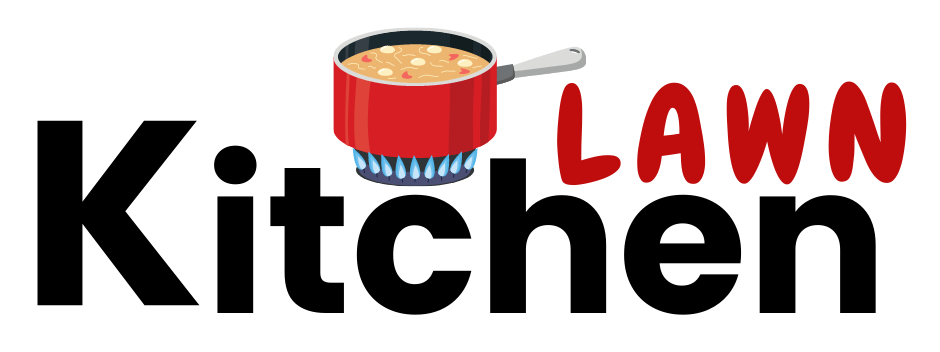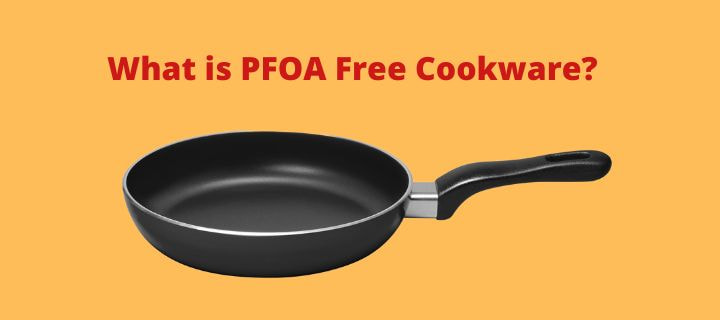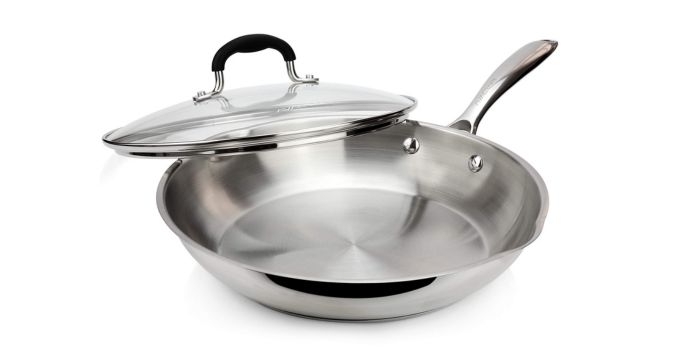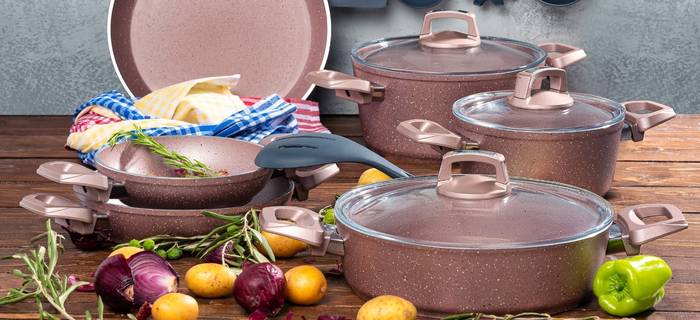If you’re looking to buy a new non-stick pan, you might see the term “PFOA-free” on the label. But what does that mean, and why should you care?
So let’s start with the basics.
What is PAFO Detailed Explanation?
PFOA (perfluorooctanoic acid) is a synthetic fluorochemical that has been used in the production of non-stick and water-repellent coatings since the 1950s.
PFOA has been classified as a persistent organic pollutant because it does not break down in the environment and can accumulate in the bodies of humans and animals.
In 2006, the U.S. Environmental Protection Agency (EPA) took action to reduce human exposure to PFOA by asking eight companies that manufacture or use PFOA to voluntarily agree to eliminate the use of PFOA and related chemicals in the U.S. by 2015(Source).
As a result of the EPA’s action, cookware manufacturers have begun to develop and market PFOA-free products including nonstick cookware.
PFOA-free cookware is made with a variety of different materials, including ceramic, PTFE silicone, and enamel.
However, PFOA is still present in some consumer products and in the environment, so it is important to take steps to reduce your exposure.
What is PFOA Free Cookware?
PFOA-free cookware is cookware that does not contain PFOA or any other fluorochemical. There are a number of brands of PFOA-free cookware on the market, and more are likely to become available as the market for PFOA-free products grows.
If you are concerned about your exposure to PFOA, look for cookware that is labeled as PFOA-free. When purchasing new cookware, consider opting for PFOA-free options to help reduce your exposure.
Difference Between PTFE and PFOA
When I knew nothing about cookware, I usually thought that Teflon and PFOA were the same things. But actually, they are not. PTFE is a synthetic fluoropolymer of tetrafluoroethylene while PFOA is perfluorooctanoic acid.
PFOA is often used in the process of making PTFE. However, once the PTFE is made, the PFOA is no longer present in the final product.
So, if you see cookware that is labeled as “PTFE-free” or “PFOA-free,” this means that no PFOA was used in the manufacturing process of the cookware.
What are the health risks associated with PFOA?
Although PFOA has been used in the manufacturing of nonstick cookware for many years, there is still much we do not know about the long-term health effects of exposure to this chemical.
In animal studies, PFOA has been linked to a variety of health problems, including liver damage, thyroid disease, reproductive problems, and cancer.
These health effects are thought to be due to PFOA’s ability to disrupt the body’s hormones. In addition, PFOA is classified as a “likely human carcinogen” by the International Agency for Research on Cancer.
While more research is needed to better understand the potential health risks associated with PFOA, the EPA has taken action to reduce exposure to this chemical.
What is Teflon?
Teflon is the brand name for a synthetic fluoropolymer of tetrafluoroethylene (PTFE). It is used in a variety of applications, including nonstick cookware, fabric coatings, and electronics.
Teflon is made by DuPont, one of the largest chemical companies in the world. DuPont began production of Teflon in 1938 and it was originally used as a fabric coating. In the 1950s, Teflon was introduced as a nonstick coating for cookware.
Teflon is created through a process called polymerization, which involves combining small molecules into larger ones. PTFE is made by combining tetrafluoroethylene molecules into long chains.
PTFE is a very stable compound and does not break down at high temperatures. It has a wide range of applications because it is chemically inert, non-toxic, and has a low coefficient of friction.
What is Nonstick Pan?
Now the question is what coating does use in nonstick cookware? There are several different types of coatings that have been developed for use in nonstick cookware.
The most common type of coating is called polytetrafluoroethylene (PTFE). PTFE is a synthetic fluoropolymer of tetrafluoroethylene that has numerous applications.
PTFE is non-reactive, heat resistant and low friction. It is used as a coating for pans and other cookware. PTFE is very slippery so it prevents food from sticking to the pan.
PTFE was accidentally discovered in 1938 by Roy J. Plunkett while he was working for the Kinetic Chemical Corporation.
PTFE was found to have very useful properties and it soon became a popular material for use in many different applications. PTFE is the most common nonstick coating used today.
Other types of coatings include anodized aluminum, ceramic, and silicone.
Anodized aluminum has a harder surface than uncoated aluminum. It is also more durable and is less likely to warp or scratch. Ceramic cookware has a smooth surface that is both nonstick and heat resistant.
Silicone cookware is also nonstick but it is not as heat resistant as ceramic or aluminum.
Nonstick cookware is very popular because it makes cooking and cleanup easier. Foods slide right off the surface and there is no need to use oil or butter.
When shopping for nonstick cookware, it is important to choose a brand that is durable and easy to clean. The coating should be smooth and even with no scratches or peeling.
It is also important to make sure that the cookware is compatible with your stove. Some types of nonstick cookware are not suitable for use on induction cooktops.
Is Teflon Safe?
There has been some concern over the safety of Teflon, particularly when it is used PFOA in cookware.
When Teflon is heated to high temperatures, it can release toxins into the air. These toxins have been linked to a variety of health problems in animals, including cancer and reproductive problems.
However, now there is no longer any PFOA in Teflon. In addition, the U.S. Food and Drug Administration has stated that Teflon is safe for use in cookware.
Another thing that you should know about PTFE is that it is not just used Teflon. There are many other brands that use PTFE in their pans.
However, when using Teflon cookware, it is important to follow the below instructions:
- Do not use Teflon cookware at high temperatures.
- Do not use Teflon cookware that is scratched or damaged.
- PTFE-coated cookware should only be used with wooden, nylon, or silicone utensils.
Best Alternative to Teflon
If you are looking for a Nonstick Pan without Teflon, consider switching to alternative materials such as ceramic coated or Hard Anodized cookware.
Hard Anodized Cookware?
Hard anodized cookware is made by a process that electrochemically hardens the surface of aluminum. This makes the surface of the cookware much harder and more durable than traditional aluminum.
Hard anodized cookware is also non-toxic and safe to use. In addition, it is also scratch-resistant and can withstand high temperatures.
If you are looking for an alternative to Teflon, hard anodized cookware is a good option.
Ceramic Coated Cookware?
Ceramic-coated cookware is made with a ceramic coating that is applied to the surface of the cookware(usually Aluminum). This coating helps to create a nonstick surface. Ceramic cookware is also safe to use and does not contain any harmful chemicals.
Cast Iron
Cast Iron is another good alternative to Teflon. It is safe to use and does not contain any harmful chemicals. Cast iron is also very durable and can last for many years with proper care.
However, cast iron does require some seasoning(oiling) to create a nonstick surface.
Conclusion
So, now whenever you see PFOA Free Cookware, you know that it is Cookware that doesn’t have PFOA in it. And also, you are aware of the health hazards associated with PFOA. So, make sure to buy PFOA-free cookware for your home and stay healthy.
Also, you can try other alternative cookware like Anodized aluminum cookware, Ceramic cookware, and Cast Iron which are also PFOA free.







